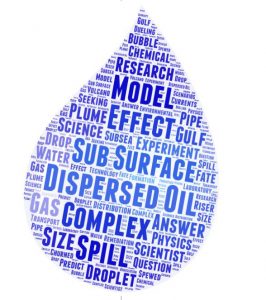PNAS Writer Follows Scientists Seeking to Answer, Did Sub-Sea Dispersants Work?
– JULY 18, 2019
Scientist and author M. Mitchell Waldrop accompanied researchers, funded by the Gulf of Mexico Research Initiative, as they conducted the largest experimental simulation to-date of the Deepwater Horizon oil intrusion. The researchers are hoping to provide solid science on dispersant effectiveness so that more informed decisions can be made when the next oil spill happens.
The June 2018 experiment took place at the New Jersey based Ohmsett facility, which was designed for testing oil cleanup methods. The researchers are investigating what is still unknown about dispersant effectiveness, specifically the first-time-ever deep-sea injection of dispersants as was done during the 2010 oil spill. They found, through laboratory experiments and computer modelling, that a closer-to-true-scale experiment mimicking conditions during the oil spill is what was needed to get more complete answers.
In the Proceedings of the National Academy of Sciences (PNAS) News Feature The perplexing physics of oil dispersants, Waldrop captures the increasingly complex cascade of questions, answers, and more questions as scientists grappled with underlying physical and chemical processes involved with the use of sub-surface chemical dispersants.
Join Waldrop on his journey with scientists seeking to understand what happens when chemical dispersants are used in a deep-sea setting for oil spill remediation. Here are a few teasers of what Waldrop reports, in refreshing everyday language:
- Eric D’Asaro, at the University of Washington’s Applied Physics Laboratory, explains how an oil slick’s encounter with the point where fresh and salty water meet can either keep oil away from shores or help move it closer.
- Joseph Katz, at Johns Hopkins University’s Department of Mechanical Engineering, describes how dispersed oil droplets appear to be shaped more like a tear drop with threads and tails than a circular drop and why that’s significant.
- Scott Socolofsky, at Texas A&M University’s Zachary Department of Civil Engineering, explains how an oil plume is like a volcano erupting and why that makes it difficult to measure the size distribution of oil droplets.
- Michel Boufadel, at the New Jersey Institute of Technology’s Department of Civil and Environmental Engineering, raises the possibility that maybe dispersants were reacting to the larger amounts of gas that churned with the oil and then spewed from the riser pipe.
- Why uncertainty surrounding droplet size distribution has caused dueling modelling scenarios regarding sub-sea dispersant effectiveness.
- Why the answer “It depends” may not be true for long regarding the question, did sub-sea dispersant application work?
Below links offer more details about recent science related to understanding oil transport and fate during Deepwater Horizon:
From the Seafloor Up
- Study Uses ROV Imaging System to Measure Gas Bubble Size, Velocity, and Diffusion
- Study Details Underwater Oil Plume Formation and Droplet Size Distribution
- Modelling Study Quantifies Gas Bubbles Effects on Oil Plume Dynamics
- Modeling Study Characterizes Droplet and Bubble Formation in Subsea Oil Spills
- Study Is First to Examine How Oil and Gas Tumbling Inside Pipe Affects Released Oil Estimations
On the Ocean’s Surface
- CARTHE at Sea: A Grand Experiment for Transformative Research in Gulf Oil Studies
- Tracking the Last Mile Before Oil Meets the Beach
- LASER Focus Advances Knowledge of How Gulf of Mexico Water Moves
- Science at Sea: SPLASH Experiment Improves Predictions for Oil Moving toward Shore
- Study Shows Drifter Data on Surface Currents Critical to Predict Pollutant Transport
- Study Finds Small Scale Ocean Currents Cause Clustering of Floating Material
Dispersant in the Mix
- Study Estimates Subsea Dispersant Marginally Reduced Surface Oil
- Modelling Study Demonstrates Dispersants Lowered Health Risks during Oil Spill
- Modeling Study Suggests Dispersants Used at Wellhead had Marginal Effect on Oil Reaching Surface Waters
- Model Comparison Study Confirms Subsea Dispersant Effectiveness
- Study Assesses How Chemical Dispersant Affects Oil Plume Behavior
- Study Finds Dispersants Reduce VOC Emissions and Increase Airborne Particles with PAHs
- Study Finds Sunlight Reduced Dispersant’s Effectiveness During Deepwater Horizon
By Nilde Maggie Dannreuther. Contact maggied@ngi.msstate.edu with questions or comments.
************
This research was made possible by grants from the Gulf of Mexico Research Initiative (GoMRI) to the Consortium for Advanced Research on Transport of Hydrocarbon in the Environment (CARTHE, CARTHE II, and CARTHE III); to the Center for Integrated Modeling and Analysis of Gulf Ecosystems (C-IMAGE, C-IMAGE II, and C-IMAGE III); to the Dispersion Research on Oil: Physics and Plankton Studies Consortium (DROPPS, DROPPS II, and DROPPS III); and to the Gulf of Mexico Integrated Spill Response Consortium (GISR).
The Gulf of Mexico Research Initiative (GoMRI) is a 10-year independent research program established to study the effect, and the potential associated impact, of hydrocarbon releases on the environment and public health, as well as to develop improved spill mitigation, oil detection, characterization and remediation technologies. An independent and academic 20-member Research Board makes the funding and research direction decisions to ensure the intellectual quality, effectiveness and academic independence of the GoMRI research. All research data, findings and publications will be made publicly available. The program was established through a $500 million financial commitment from BP. For more information, visit https://gulfresearchinitiative.org/.
© Copyright 2010-2019 Gulf of Mexico Research Initiative (GoMRI) – All Rights Reserved. Redistribution is encouraged with acknowledgement to the Gulf of Mexico Research Initiative (GoMRI). Please credit images and/or videos as done in each article. Questions? Contact web-content editor Nilde “Maggie” Dannreuther, Northern Gulf Institute, Mississippi State University (maggied@ngi.msstate.edu).






